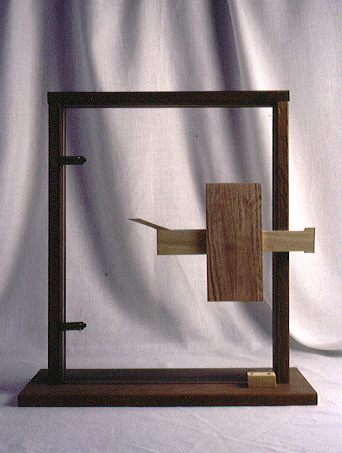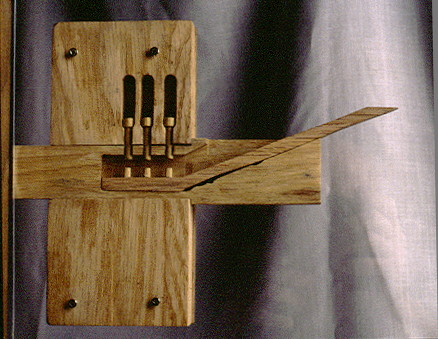Tumbler Lock, Egypt, Iraq, Greece, 1000 BCE
by Mara Bishop, '00 and Amanda Payne Burton, '97

This simple tumbler lock was probably invented around 1000
BCE, although a date of 2000 BCE has also been proposed. Many
sources believe this lock was invented in Egypt, though locks of
this type have been found in ruins in Iraq that predate those
found in Egypt. After its invention and its movement into Egypt,
the lock made its way into Greece. Here this new system was a
great improvement over the previous locks, which were simply a
board drawn across a door. From Greece the lock moved into
Europe.
 The lock is the first mechanical
fastening for doors, and is said to be the only major European
architectural improvement in classical times.The mechanism
consists of a key and a lock. The key is simply a bit of wood
with small pins, usually of brass. These pins enter small holes
in the bolt and lift similar pins in the lock. The pins of the
key push the lock pins out of the holes, and the bolt can be
moved aside and the door opened. When leaving the building, the
bolt is slid across the door jamb, and the pins fall into the
grooves in the bolt. To unlock, the key is slid into the opening
in the bolt and lifted up, which moves the bolt-pins out of the
way.
The lock is the first mechanical
fastening for doors, and is said to be the only major European
architectural improvement in classical times.The mechanism
consists of a key and a lock. The key is simply a bit of wood
with small pins, usually of brass. These pins enter small holes
in the bolt and lift similar pins in the lock. The pins of the
key push the lock pins out of the holes, and the bolt can be
moved aside and the door opened. When leaving the building, the
bolt is slid across the door jamb, and the pins fall into the
grooves in the bolt. To unlock, the key is slid into the opening
in the bolt and lifted up, which moves the bolt-pins out of the
way.
 The lock is the first mechanical
fastening for doors, and is said to be the only major European
architectural improvement in classical times.The mechanism
consists of a key and a lock. The key is simply a bit of wood
with small pins, usually of brass. These pins enter small holes
in the bolt and lift similar pins in the lock. The pins of the
key push the lock pins out of the holes, and the bolt can be
moved aside and the door opened. When leaving the building, the
bolt is slid across the door jamb, and the pins fall into the
grooves in the bolt. To unlock, the key is slid into the opening
in the bolt and lifted up, which moves the bolt-pins out of the
way.
The lock is the first mechanical
fastening for doors, and is said to be the only major European
architectural improvement in classical times.The mechanism
consists of a key and a lock. The key is simply a bit of wood
with small pins, usually of brass. These pins enter small holes
in the bolt and lift similar pins in the lock. The pins of the
key push the lock pins out of the holes, and the bolt can be
moved aside and the door opened. When leaving the building, the
bolt is slid across the door jamb, and the pins fall into the
grooves in the bolt. To unlock, the key is slid into the opening
in the bolt and lifted up, which moves the bolt-pins out of the
way. 